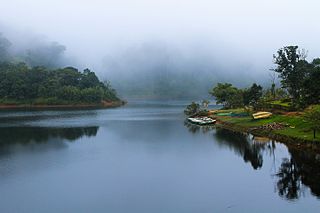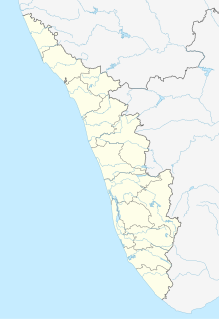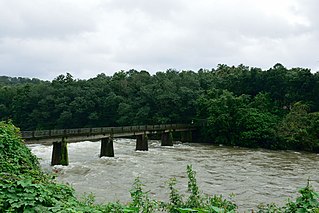Related Research Articles

Pathanamthitta District is a district in the southern part of Kerala, India. The district headquarters is in the town of Pathanamthitta. There are four municipalities in Pathanamthitta: Tiruvalla, Adoor, Pathanamthitta and Pandalam.

[File:Denison barb.jpg|thumb|]]he Denison barb, Denison's barb, Miss Kerala, red-line torpedo barb, or roseline shark is an endangered species of cyprinid fish endemic to the fast-flowing hill streams and rivers of the Western Ghats in India. It is commonly seen in the aquarium trade; pet collection caused it to become endangered and is its single major threat.

The Kerala backwaters are a network of brackish lagoons and lakes lying parallel to the Arabian Sea coast of Kerala state in southern India, as well as interconnected canals, rivers, and inlets, a labyrinthine system formed by more than 900 kilometres (560 mi) of waterways, and sometimes compared to American bayous. The network includes five large lakes linked by canals, both man made and natural, fed by 38 rivers, and extending virtually half the length of Kerala state. The backwaters were formed by the action of waves and shore currents creating low barrier islands across the mouths of the many rivers flowing down from the Western Ghats range. In the midst of this landscape there are a number of towns and cities, which serve as the starting and end points of backwater cruises.

Vembanad is the longest lake in India, as well as the largest lake in the state of Kerala. With an area of 2033 square kilometers, it is the second largest Ramsar site in India only after the Sunderbans in West Bengal. Spanning several districts in the state of Kerala, it is known as Vembanadu Lake in Kottayam, Vaikom, Changanassery, Punnamada Lake in Alappuzha, Punnappra, Kuttanadu and Kochi Lake in Kochi. Several groups of small islands including Vypin, Mulavukad, Maradu, Udayamperoor, Vallarpadam, Willingdon Island are located in the Kochi Lake portion. Kochi Port is built around the Willingdon Island and the Vallarpadam island.

Kuttanad is a region covering the Alappuzha, Kottayam and Pathanamthitta Districts, in the state of Kerala, India, well known for its vast paddy fields and geographical peculiarities. The region has the lowest altitude in India, and is one of the few places in the world where farming is carried on around 1.2 to 3.0 metres below sea level. Kuttanadu is historically important in the ancient history of South India and is the major rice producer in the state. Farmers of Kuttanad are famous for Biosaline Farming. Food and Agriculture Organization (FAO) has declared the Kuttanad Farming System as a Globally Important Agricultural Heritage System (GIAHS).

The Cardamom Hills or Yela Mala are mountain range of southern India and part of the southern Western Ghats located in southeast Kerala and southwest Tamil Nadu in India. Their name comes from the cardamom spice grown in much of the hills' cool elevation, which also supports pepper and coffee. The Western Ghats and Periyar Sub-Cluster including the Cardamom Hills, are UNESCO World Heritage Sites.

Periyar, IPA: [peɾijɐːr], is the longest river and the river with the largest discharge potential in the Indian state of Kerala. It is one of the few perennial rivers in the region and provides drinking water for several major towns. The Periyar is of utmost significance to the economy of Kerala. It generates a significant proportion of Kerala's electrical power via the Idukki Dam and flows along a region of industrial and commercial activity. The river also provides water for irrigation and domestic use throughout its course besides supporting a rich fishery. Due to these reasons, the river has been named the "Lifeline of Kerala". Kochi city, in the vicinity of the river mouth draws its water supply from Aluva, an upstream site sufficiently free of seawater intrusion. Twenty five percent of Kerala's industries are along the banks of river Periyar. These are mostly crowded within a stretch of 5 kilometres (3 mi) in the Eloor-Edayar region (Udhyogamandal), about 10 kilometres (6 mi) north of Kochi harbor.

Periyar National Park and Wildlife Sanctuary (PNP) is a protected area located in the districts of Idukki and Pathanamthitta in Kerala, India. It is notable as an elephant reserve and a tiger reserve. The protected area encompasses 925 km2 (357 sq mi), of which 305 km2 (118 sq mi) of the core zone was declared as the Periyar National Park in 1982. The park is a repository of rare, endemic, and endangered flora and fauna and forms the major watershed of two important rivers of Kerala: the Periyar and the Pamba.

Achankovil is a river in Kerala, India, which originates in the Achankovil Reserve Forests in the Pathanamthitta district by the confluence of the Rishimala, Pasukidamettu, and Ramakkalteri Rivers. The Anchankovil enriches the Alappuzha and Pathanamthitta district of Kerala state. It joins with the Pamba River at Veeyapuram, in the Alappuzha district of Kerala. Achankovil is also the name of the forest area, which is the catchment area for this river, and of a small town situated in the Achenkovil forest area. The Achankovil village is not easily accessible; however, it can be reached through forest routes.

Pandalam is a municipal town in Pathanamthitta district Kerala, India. Pandalam is considered a holy town due to its connection with Lord Ayyappa and Sabarimala. Rightly recognised as the educational and cultural headquarters of Central Travancore, Pandalam hosts educational institutions ranging from reputed schools to post graduate, training, ayurveda, and engineering colleges. There are seven colleges and 23 schools at Pandalam, including N. S. S. College, Pandalam. The Kerala state government plans to make the place a special Township, by including the Pandalam municipality and Kulanada panchayat. The Pandalam area conists of Pandalam municipality, Kulanada panchayath, Pandalam Thekkekara panchayath & Thumpamon panchayath.

The Pamba River is the longest river in the Indian state of Kerala after Periyar and Bharathappuzha and the longest river in the erstwhile former princely state of Travancore. Sabarimala temple dedicated to Lord Ayyappa is located on the banks of the river Pamba.

Kodukulanji is a village located around 5 km north of the Achankovil River and 7 km south of the Pamba River, in Alappuzha district.

Omallur is a small town, about 3.5 km south of Pathanamthitta District headquarters, in Kerala. Omallur is famous for Vayal Vanibham which is an annual farming fair held in the month of Meenam (October). People from both within and outside the town participate in the fair.
Kalleli is a small village, about 10 kilometres away from Konni (India) in Pathanamthitta district, Kerala, India. It is situated on the banks of river Achankovil.

Veeyapuram is a village in the district of Alappuzha, Kerala, India. It is located about 7 kilometers north of Haripad town.

Manimala River is a 92km long river which flows through South and Central Kerala. The river used to be wrongly considered as a tributary of Pamba River before satellite maps became popular, but this is was proved incorrect. Manimala does not flow into the Pamba, instead a distributary of the Pamba river flows into the Manimala river at Kallunkal, later branches out at again from Manimala at Nedumpuram and flows through Niranam, Thalavady, Edathua, Changankary, Champakulam, Nedumudy, Chennamkary, and finally Kainakary and then empties into the Vembanad lake. This branch again links with Manimala river at Chennankary in a short, but broad connection known as Munnattumukham. Manimala is a separate independent river for all geographical purposes. It has its origin on the Muthavara Hills on the Western Ghats in Idukki district of Kerala, India. It has a length of about 90 km and flows through a catchment area of about 847 km2. The river passes through the districts of Kottayam, Pathanamthitta and Alappuzha. Yendayar, Koottickal, Mundakayam, Erumeli, Manimala, Kottangal, Kulathurmoozy, Vaipur, Mallappally, Keezhvaipur, Thuruthicad, Komalam/Kuranjoor Kadavu, Kallooppara, Vallamkulam, Kattode & Kuttoor, Pulikeezh, Nedumpuram, Neerattupuram, Amichakary, Muttar, Kidangara, Pulincunnoo, Veliyanadu, Ramankary, Mankompu lie on the banks of Manimala River. Manimala splits after Kidangara into two branches. Second branch flows via Kunnamkary, Kavalam and Kainakary to Vembanad lake. Its running length is estimated at 92 km. It empties itself into the Vembanad Lake. It is one of the four major rivers which do not have direct outlet to sea as these rivers empty into the vast Vembanad lake. This huge lake has just two outlets, one at Thottappaly Spillway and second at Thannermukkom Bund, both man made barriers, built to prevent incoming seawater during high tides, which otherwise would render the low lying paddyfields uncultivable.

Pandalam Mahadeva Temple is situated in between Thottakkonam and Mulampuzha villages of Pandalam in Kerala, India. Yearly Kettukazhcha festival is one of the attractions for tourists. 10 days major festival is celebrated for Lord Siva in 'Dhanu masa' November–December every year. the festival start by hosting traditional flag names 'kodiettu' and ends by 'aarattu'. the administration of this temple held by Mahadeva Seva Samithi participated by 12 villages '12 karakal'in Pandalam. It is believed that Lord Parasuram has installed the main idol of the Garbhagriha in this temple.

Kumbhavurutty Waterfall is a famous waterfalls in South India situated near Aryankavu panchayath in Kollam district of Kerala near Tamil Nadu border. Located on the eastern area of Kollam District, Kumbhavurutty falls is one among the few crowd pulling waterfalls in Kerala. During peak times, the daily collection of this tourism spot will cross Rs. 1,50,000. It is about 6.5 km away from Achenkovil. This waterfall is a part of river Achankovil. Manalar Waterfall is another important waterfall near to this. The travelers can see wild animals also if lucky. Because the waterfall is very close to the thick Konni Forest area. Palaruvi Falls is another nearby attraction of this falls.
Devarmala is a huge peak in the Western Ghats of Kerala and Tamil Nadu. Devarmala stands at an altitude of 1,923m. It is located in the border of Pathanamthitta District and Kollam District of Kerala and the adjacent Thirunelveli District of Tamil Nadu. This is the last of the peaks located just north of the biogeographically important seven kilometers wide "Schencottah Pass" or "Schencottah Gap" or 'Aryankavu Pass'.
Utharappalli River or locally called as Varattar is one of the longest interlinking rivers in Kerala, India.
References
- ↑ Govindan, Santini (16 November 2017). "Quiet flows the river". The Hindu. ISSN 0971-751X . Retrieved 20 May 2021.
- ↑ "How a Kerala village panchayat revived a dying river". The Indian Express. 9 May 2017. Retrieved 20 May 2021.
- ↑ "How 700 Kerala villagers waded through a dead river, cleansed it and brought it back to life in 70 days". Hindustan Times. 7 May 2017. Retrieved 20 May 2021.
- ↑ "A river reborn: How 700 workers cleaned a once-still river in Kerala's Alappuzha". The News Minute. 26 April 2017. Retrieved 20 May 2021.